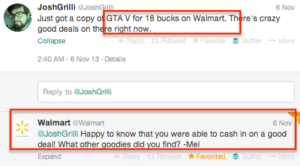Things go wrong on websites all the time. For big brands, a simple website glitch can cost millions of dollars and lately, there’s been a whole lot of glitching going on. Â Everyone homes in on the amount of dollars lost. I’d like to point out that there is a lot more at stake.
Earlier this week, a website glitch at Walmart led to customers snatching up items like $300 kayaks for $11 or the newly released Grand Theft Auto V for just $18 a copy (it normally hovers around $60). Â It didn’t take long for people to start spreading the word about the deals, especially via social media. In fact, it was via a friend’s Facebook post that I found out about the crazy prices in the first place.
I am staunchly not a Walmart customer, but I wanted to see how this all played out, so I bought two kayaks that normally retail for about $150-200 each, for under $25 total and waited. A Google search made it seem like this wasn’t perhaps a glitch at all, but a legit attempt by the company to start wooing holiday shoppers into buying early, ahead of a shortened holiday buying season.  In fact, an exchange that took place on Twitter between Walmart and a deal grabber in the early hours of the day made it seem like Walmart was well aware of the extraordinarily low prices.  Not to mention the significant press coverage the week prior to this glitch noting that in fact, yes, Walmart is jumping the gun and slashing prices to try to boost sales early.
@JoshGrilli Happy to know that you were able to cash in on a good deal! What other goodies did you find? -Mel
— Walmart (@Walmart) November 6, 2013
To the average consumer doing basic research, all of this seems to suggest that insane prices on the website are potentially quite legitimate. Â Except they weren’t.
Despite the fact that Walmart employees were participating in the conversation and legitimizing the prices, it took Walmart hours to actually do something about their website problems.  As I mentioned earlier, I heard about the sale via Facebook, around 9:30 in the morning. This is a good 6+ hours after the tweet above. The site was slow, but my order went through, my card was charged, and I received email confirmation of my purchase. An hour after my purchase, the site was back to normal operating mode with prices that seemed more realistic.
In the meantime, though, people who opted to pick up their items (my choice, as well, though I was told my kayaks wouldn’t be there until Tuesday) at the store instead of having them shipped were able to pick up the items without a problem.  Again, people being able to pick up their items right away seemed to affirm the crazy-low prices were real. Some people got the glitch prices while shopping in-store, as well, and began sharing those photos, too. Further, the @Walmart team on Twitter was going about their business and telling everyone the prices were legit!
And here is where everything gets sticky.  Around 7:00 pm, I received an email from Walmart telling me that my order had been cancelled. I had been refunded in full, and I should expect a $10 credit in my email for the inconvenience. They explained there had been a website glitch and that they weren’t honoring the prices because of the enormous gap in price difference.
The other issue is how long it took Walmart to fix the problem.  In a blog post earlier this week, my colleague Ryan wrote about information coming from SES Chicago, noting that 51% of people research online and then buy in-store. These on-to-offline experiences are only growing and brands need to take that into consideration.  The customer service experience in-store has to match the experience on Twitter which has to match the email marketing which has to match the information available on the website, and so on down the line. All-in-all, this wasn’t a horrible way to handle a snafu such as this. I mean, I’m not out anything, and in fact, I came out $10 ahead (though now they have my personal data which is worth a lot more than $10, but that’s another post for another time!).  The problem is that other people DID get to receive their merchandise for the super-low prices.  Those whose stores had the items in stock had the benefit of getting the price, while those of us without access to a major store were denied that pricing.
Yet so many companies work in silos, so a streamlined brand experience is few and far between. Rare is the organization that has thought leadership in place to realize that representatives from store leadership, corporate marketing, corporate communications, SEO, web design and UX, the IT team, and everyone else need to be on the same page, especially when launching hero campaigns or major sales. Rarer still is the team who has the foresight to think of the chain of command and backup plan if something should misfire. In the case of Walmart, the person manning Twitter at 2:00 in the morning might have internally said, “Whoa team… why is one of the hottest video games of the year being sold at 30% of the price?!” and flagged that right away.
Let’s take a look at another major brand that just cannot seem to get their e-commerce act together, United Airlines.  In 2012, United had an issue with its award travel web engine.  Frequent fliers were going to to the site to book first class travel to Hong Kong, which normally requires 120k-140k miles. But when they went to check out, they were being charged just four miles and taxes and fees amounting to a paltry $33.  Once the fare was corrected, United decided to honor the fares that were already purchased, just as they did in 2008 when they inadvertently left out a $130 fuel surcharge on some tickets.
Even if they only did so because the DOT has strict commerce rules in place about changing/charging/increasing a price after the consumer has completed the transaction, United definitely benefitted from doing so in that virtually every travel blog covered the amazing move, and Twitter went all aflutter with United love (unlike the press they received after the now legendary United Breaks Guitars incident).
We’ve reviewed the error that occurred yesterday and based on these specific circumstances, we will honor the tickets.
— United (@united) September 13, 2013
One would think that a glitch that allowed tickets that normally cost travelers $8500+ to go for just $33 would have been wakeup call enough for United to get it’s system together, but it wasn’t. Â Things were fine for about ten months, but then had another error pop up in September of 2013. Â Tickets were being sold for $0 – $10 each. Â Again, United reviewed the situation and honored the tickets. Â Think that was enough for United to get its web act together? Nope! Â Just one month later, frequent fliers found a glitch that allowed them to book tickets all over the world for just a handful of dollars and a chunk of miles – but the miles were never debited from their accounts.
In this last example with the United.com booking engine, the airlines opted to not honor the tickets because the user knowingly and willfully exploited the glitch in order to get it to work.  That makes sense and United made the right call.  But let’s head back to Walmart, where the lines between right and wrong are blurred.  We all know the difference between taking an advantage of a mistake and scoring a crazy deal online.  The fact that it took Walmart hours to correct the problem, along with the fact that actual employees said the prices were real, and then combining it with the fact that many customers were able to physically obtain their  drastically discounted products in-store has me leaning toward the side that they should have honored the sales (and not just because I was really hoping for those kayaks).
From a legal perspective there is a lot about which to think.  What laws differ in each state where you do business? What are the false advertising laws in those states? What about the case of Walmart when an official communications channel acknowledged the prices were real on certain items?  Will this land them in hot water with the Federal Trade Commission or the Attorneys General of specific states?  What about the fact that they honored the prices in some stores for people who could pick up their items right away, but canceled the paid for and confirmed purchases of others. Walmart does have some legal language on their website, which I was kindly directed to in an email that arrived while typing this post, explaining that errors may occur and they reserve the right to cancel orders even after confirmation of the order has been sent.  I searched and found a cached copy of the page from October 29 that confirmed this language appeared on their website before the major snafu took place.
Still, this incident should provoke food for thought within the walls of your business. Walmart is a big enough brand that it won’t feel any sort of aftershock from not getting the business of me or the thousands of other people who would never otherwise shop with them. However, smaller companies, especially those working to scale their business, could tank their reputation if they handled the situation similarly to that of the discount giant.
Does your organization have a crisis management plan in place? What is the chain of command if something like this happens on your site?  My guess is that you might know the first steps, but that’s not what is going to cause the problem for your company.  It’s being wishy-washy about steps four or five that will hurt your business in the long run. It’s been my experience that PR departments and communications team have a good idea of how to handle unexpected situations, but often forget to immediately arm their frontline people -a/k/a community managers – with the official brand message.  Lack of communication rarely makes a situation better, especially if people like Mel from Walmart are happily tweeting about like everything is business as usual.
As the digital world continues to blend in with our real-life activity, it’s ever more important that brands are thinking two steps ahead. Â Make sure you have in place your online and social crisis plan so you look even better coming out of a situation than before you were in it.











